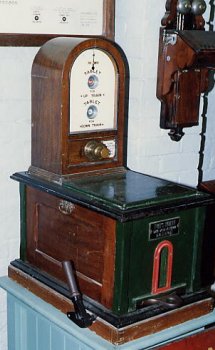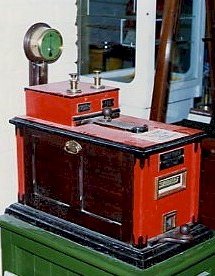Please be aware of our copyright notice. If you have a good reaon for using a photo from this site ask permission from first - it is frequently given.
Southern Signals
Single Line Instruments
| Described below are more of the many forms of Single
Line Instrument that have been used by the Southern railways over the years.
Once again, this is more of an informative introduction than an in-depth
tutorial. These notes are a brief reference to the operation of the
Instruments, there are other requirements to fulfil before a Train may be
allowed into the section.
The Electric Train Tablet Instrument |
 |
Another variation on the theme were the various Electric
Train Tablet Instruments of which the Tyer'sNº3 is just one example.
The appearance of theNº3 andNº6 (left) were to all intents
and purposes identical, though the operation of them was quite different. In
the case of theNº3 system when the Signalman at B accepts a train from
the Signalman at A, A holds in his plunger for about three seconds which allows
B to hold down his side lever and withdraw an empty slide from the base. B will
then turn his commutator from right to left which will change his lower
indicator from 'In' to 'Out'. The galvanometer needle at the
top will reset to normal whereupon B will hold down his plunger changing the
upper indicator at A from 'In' to 'Out' and enabling him to
withdraw his slide with a Tablet. When the train has cleared the section B will
place the Tablet for A to B in his slide and give Train Out of Section to A. A
will then acknowledge the signal and hold down his plunger. B will now replace
his slide and turn the commutator from left to right, changing his lower
instrument to show 'In'. When the galvanometer needle is normal he must
hold in his plunger, enabling A to return his slide to normal who, ensuring his
galvanometer shows normal, will send one beat to B after which both Instruments
are once again ready for use.
º3 Instruments are non-returnable! This means that once issued the Tablet has to travel through the Section to be replaced in the Instrument at the other end. photograph by Dave Hudson, courtesy of Chris Osment |
| With the Tyer'sNº6 Instrument, when Signalman
B accepts a train from Signalman A he holds his plunger down enabling A to turn
his commutator to the left, whereupon his lower disc will show 'Out'.
He will then withdraw his Slide, extract a Tablet and send one beat to B which
will change his upper disc to 'Out' which B will acknowledge by one
beat. On arrival of the Train at B, the Signalman there will obtain the Tablet
for the A to B section from the Driver, lift his side lever, withdraw the empty
Slide and having inserted the Tablet in the Slide, push the Slide home. He
will then send to A the Train Out of Section Signal, pausing on the last beat
so that A may reverse his commutator, which he will turn to the right, then
push the empty Slide home and acknowledge the Train Out of Section Signal.
This will reverse the upper disc at B from 'Out' to 'In' and
prove to B that A has replaced his Slide. B will then give one beat to A which
will place the lower disc at A to 'In' and show that both Instruments
are again ready for use.
º6 Instruments are returnable, allowing a Tablet to be restored to the issuing Instrument if required. |
 |
| Three Tyer'sNº6 Tablets that were
used on the Meon Valley line, showing 'A' configuration (round notch +
round hole), 'B' (rectangular notch + square hole) and 'C'
(elongated, stepped notch + triangular hole).
photograph by Chris Osment |
| With the Tyer'sNº7 Instrument, when Signalman
B accepts a train from Signalman A, A must hold down his Bell Plunger for a few
seconds, which will ring the Bell at B, B must depress his Switch Plunger with
his left hand and at the same time withdraw his lower Slide (which will only
come halfway out) with his right hand. The partial withdrawal of the Slide will
reverse the commutator in the Instrument and will bring the signal Up Train
Approaching into view at B. The Signalman at B will then depress his Bell
Plunger, ringing the Bell at A, where A will hold down his switch plunger with
his left hand and fully withdraw his lower Slide with his right hand which will
then bring up the signal Up Train on Line at A. He will then give one beat on
the Bell to B to denote that the Tablet is out of the Instrument, remove the
Tablet and place it in the pouch before giving it to the Driver. When the Train
arrives at B the Signalman must obtain the A to B Tablet from the Driver,
withdraw the upper Slide in his Instrument, insert the Tablet and push the
Slide fully home. He must then push home his lower Slide which will bring up
the Signal Line Closed on his Instrument. He will then send Train Out of
Section to A, holding down his plunger on the last beat whilst A holds down his
switch plunger and pushes home his lower Slide which will restore his Indicator
to Line Closed. He must the acknowledge the Train Out of Section to B after
which both Instruments are ready for use again.
º7 Instruments are returnable, allowing a Tablet to be restored to the issuing Instrument if required. |

photograph by Dave Hudson, courtesy of Chris Osment |
This page was last updated 4 January 2004